Enrique Soriano-Salvador

sysfatal(blog)
Early detection of crypto-ransomware analyzing the Linux page cache entropy. Spoiler! It does not work.
by e__soriano

Ransomware early detection tools try to detect a ransomware attack in order to suspend all suspicious processes, stop the attack and try to recover the keys. There are several systems for early detection, for example UNVEIL (UNVEIL: A Large-Scale, Automated Approach to Detecting Ransomware, Usenix Security, 2016), RWGuard (RWGuard: A Real-Time Detection System Against Cryptographic Ransomware. RAID 2018: Research in Attacks, Intrusions, and Defenses), RLocker (R-Locker: Thwarting ransomware action through a honeyfile-based approach, Computers & Security, March 2018), etc.
When I read the UNVEIL paper some time ago, I liked the idea of computing the
entropy of the write system call buffers to detect ransomware attacks (what they
call Filesystem Activity Monitor).
The idea is simple: a ransomware process will read low entropy data (the user’s files)
and write high entropy data (the encrypted data). This pattern can be exploited
to detect an attack. UNVEIL traces the IO operations at the file system layer,
to collect the processes, files, set of IO operations, and the entropy of the buffers.
Then, they try to detect patterns.
While thinking about this approach, I had a different idea: how about inspecting the system’s page cache? Upon a ransomware attack, the page cache will be quickly populated with high entropy pages (i.e. the chunks of the files that are being encrypted by the ransomware). So I decided to perform some experiments with the Linux kernel.
The tindalos module
The experiment is based on a Linux kernel module named tindalos.ko. This module spawns a new kernel thread. This thread will do polling: periodically, it iterates over the page cache, computing the Shannon entropy of the pages belonging to files and counting the pages with more than 7.5 bits per byte. Easy, right? Well, it’s not trivial. The Linux page cache is pretty complex.
LRUs
The page cache is a write-back cache. It uses a global replacement scheme based on the LRU policy (Least Recently Used). It uses two lists: the active and the inactive. The inactive list contains the pages that have not been recently used and can be evicted (cold pages). The active list contains the pages that have been recently accessed (hot pages). Those pages will be moved to the inactive list if they are not accessed. When the page is allocated, it is added to the inactive list.
Linux uses different lists for different types of pages (anonymous, file pages, etc.).
The lruvec structure
contains all the LRU lists. We are interested in the LRU lists for file pages:
LRU_ACTIVE_FILE and LRU_INACTIVE_FILE.
To iterate over the list, you can use the list_for_each macro of the Linux kernel.
You must acquire the corresponding spin_lock (a member of the lruvec structure)
to iterate over the LRU lists.
How can I reach the LRU lists from the tindalos kernel thread?
Memory cgroups and pglists
There is a lruvec for each cgroup (control groups, see the man page
cgroups(7)). The module accepts an argument to specify a PID. It will
inspect the memory cgroup of this process. If the argument is not provided,
it will inspect the kthread memory cgroup (the root mem_cgroup of the kernel).
We can get the process’ mem cgroup with:
struct mem_cgroup *mem_cgroup_from_task(struct task_struct *p);
Once we have the mem_cgroup, we can get the lruvec with:
static inline struct lruvec *mem_cgroup_lruvec(struct mem_cgroup *memcg, struct pglist_data *pgdat)
We need to provide a pglist_data. What is that? This data structure represents a memory
bank. There is a pglist_data for each NUMA (Non Uniform Memory Access) node, and
only one if it is a UMA machine. You can find more info here.
All nodes are available in a list, so we can iterate like this:
pg_data_t *pgdat;
struct lruvec *lruvec;
unsigned long flags;
for_each_online_pgdat(pgdat) {
lruvec = mem_cgroup_lruvec(memcg, pgdat);
printk(KERN_INFO "Tindalos thread: lruvec: %p\n", lruvec);
spin_lock_irqsave(&lruvec->lru_lock, flags);
searchlruvuc(lruvec, st, headlen);
spin_unlock_irqrestore(&lruvec->lru_lock, flags);
}
First problem: we need to acquire the spin lock (disabling interrupts)
to inspect the LRU list.
This is very expensive and not viable in general (but this is just an experiment!).
We are not able to inspect the whole LRU list (it can be huge on a modern machine).
We will analyze the first N pages of the list (from the head). The tindalos
module admits an argument to set that parameter (headscan).
Entropy
We need to compute the Shannon entropy of the pages. Bad news: we should not use the Floating Point (FP) within the kernel. We need to do it with integers.
Fortunately, we can borrow an implementation (fs/btrfs/compression.c) and
modify it for our module:
static inline uint32_t ilog2_w(uint64_t n)
{
return ilog2(n * n * n * n);
}
static uint32_t count[256];
static uint32_t shannon_entropy(uint8_t *buf, int sz)
{
const u32 entropy_max = 8 * ilog2_w(2);
u32 entropy_sum = 0;
u32 p, p_base, sz_base;
u32 i;
memset(count, 0, sizeof(count));
for(i=0; i<sz; i++){
count[buf[i]]++;
}
sz_base = ilog2_w(sz);
for(i=0; i<256; i++){
p = count[i];
if(p > 0){
p_base = ilog2_w(p);
entropy_sum += p * (sz_base - p_base);
}
}
entropy_sum = entropy_sum * 100 / sz;
return entropy_sum / entropy_max * 8;
}
This function returns the Shannon entropy (bits per byte) scaled x100.
All the pages with shannon_entropy > 750 will be counted by
the tindalos kthread.
Experiments
I implemented a simple C program named ransim.c that simulates a
ransomware attack. This program implements the three ransomware classes defined
by Scaife et al. (CryptoLock (and Drop It): Stopping Ransomware Attacks on User Data, 2016 IEEE 36th International Conference on Distributed Computing Systems (ICDCS)):
-
Class A: “overwrites the contents of the original file by opening the file, reading its contents, writing the encrypted contents in-place, then closing the file”
-
Class B: “extends Class A, with the addition that the malware moves the file out of the user’s documents directory (e.g., into a temporary directory). It then reads the contents, writes the encrypted contents, then moves the file back to the user’s directory”
-
Class C: “reads the original file, then creates a new, independent file containing the encrypted contents and deletes or overwrites (via a move) the original file”
This program does not encrypt the files; it just writes random
data (extracted from /dev/urandom via getrandom(3)) to the
attacked files (random data and encrypted data should have entropy ~ 8.0).
All the experiments run on a VirturalBox Ubuntu 20.04 virtual machine.
Experiment: Class-[ABC] simulation
We copy /usr/include to a directory and run ransim.c to “encrypt” all the files:
$> cp -r /usr/include/ testing/
$> ./ransim class-a testing/include/
testing/include/ will be destroyed, proceed? (type 'yes')
yes
$>
Then, we load the tindalos module to poll the page cache every 2 seconds and inspect the first 50000 pages of each LRU:
$> insmod tindalos.ko pidmemgroup=2093 polltime=2000 headscan=50000
This is the result for the Class A simulation:
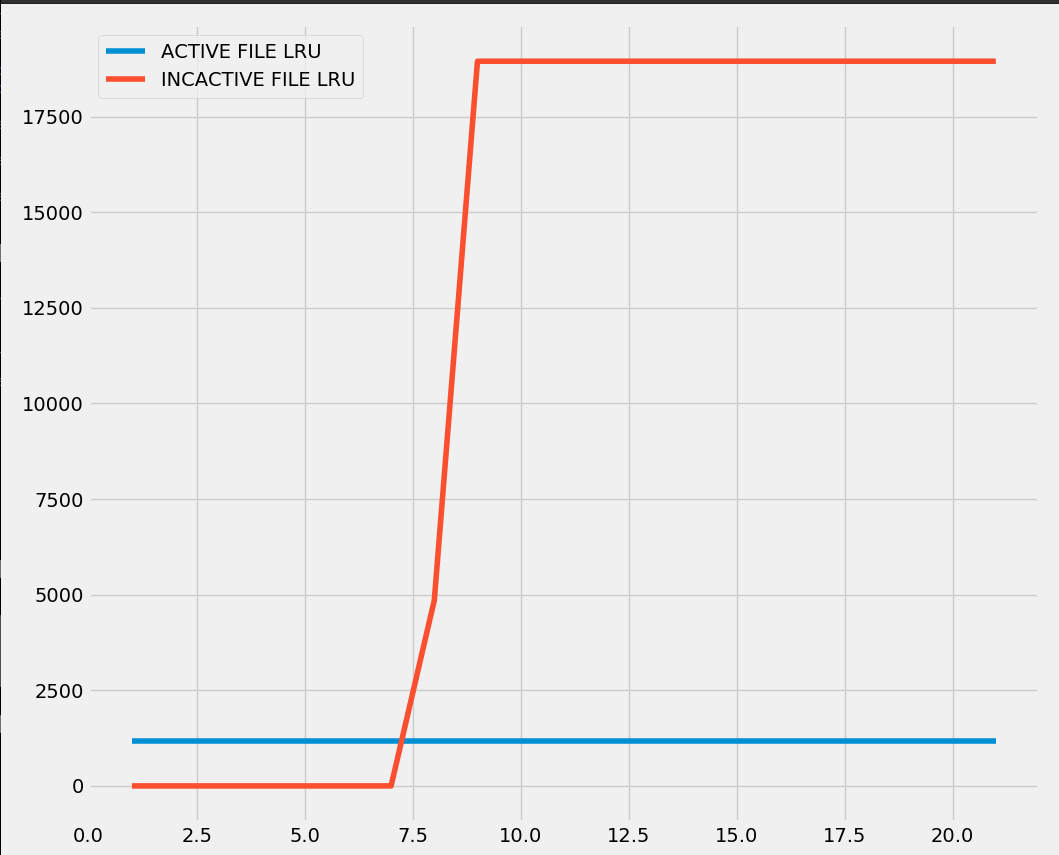
The graph shows the number of high entropy (>7.5) pages for each LRU.
With the same settings, this is the Class B simulation:
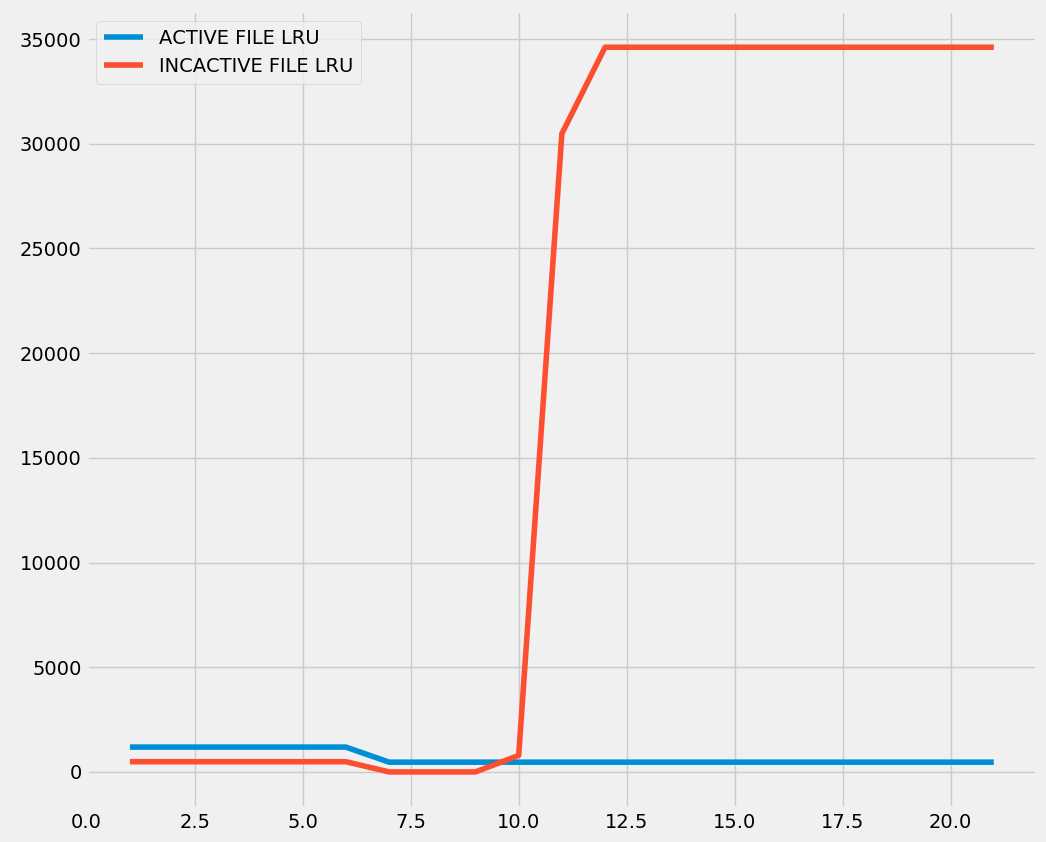
And this is the Class C simulation:
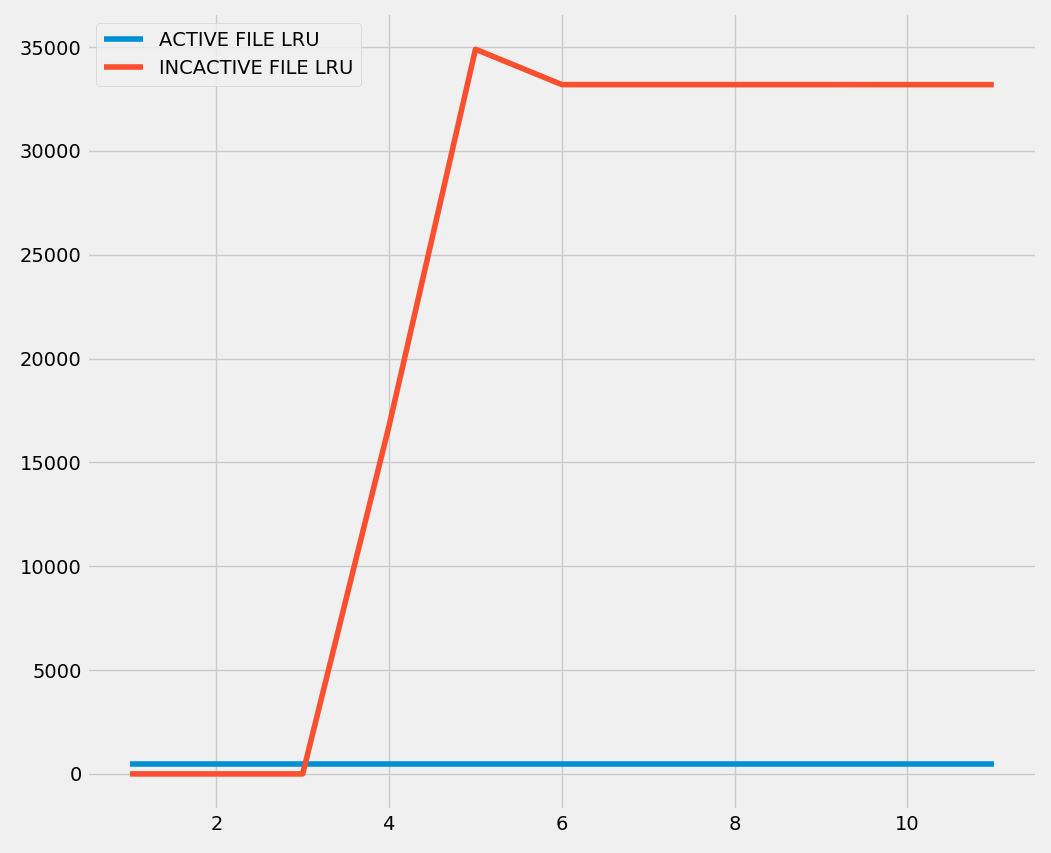
All of them causes a delta in the inactive LRU graph. The pages are allocated and never touched again, so they are not moved to the active LRU.
The pattern is clear.
But…
Experiment: normal usage
Does “normal usage” cause similar patterns? It shouldn’t, but… wait. Encrypted data have high entropy, but compressed data also have high entropy.
This graph shows a common browser session visiting YouTube and Reddit (using Firefox):
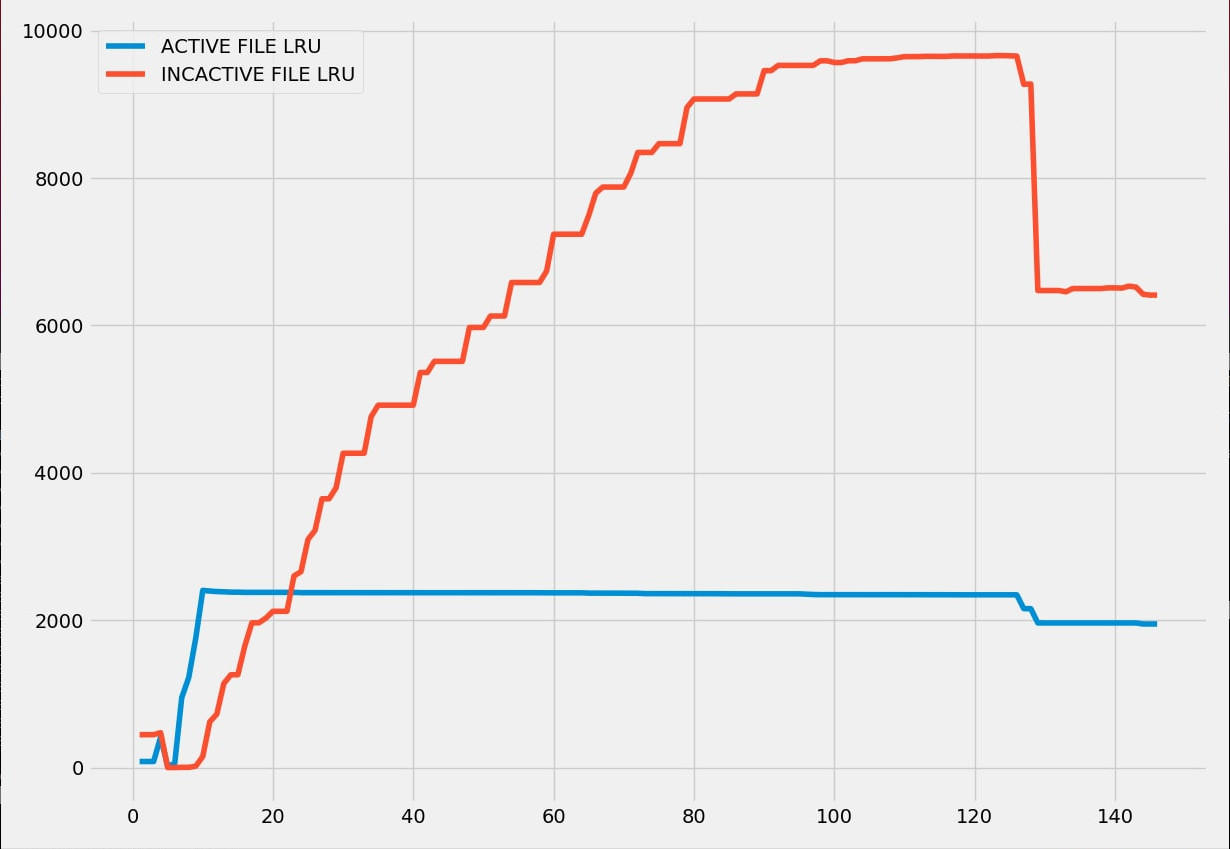
It’s not a delta, but it (slowly) fills the inactive list with high entropy pages.
If we download the Linux kernel source tarball with Firefox:
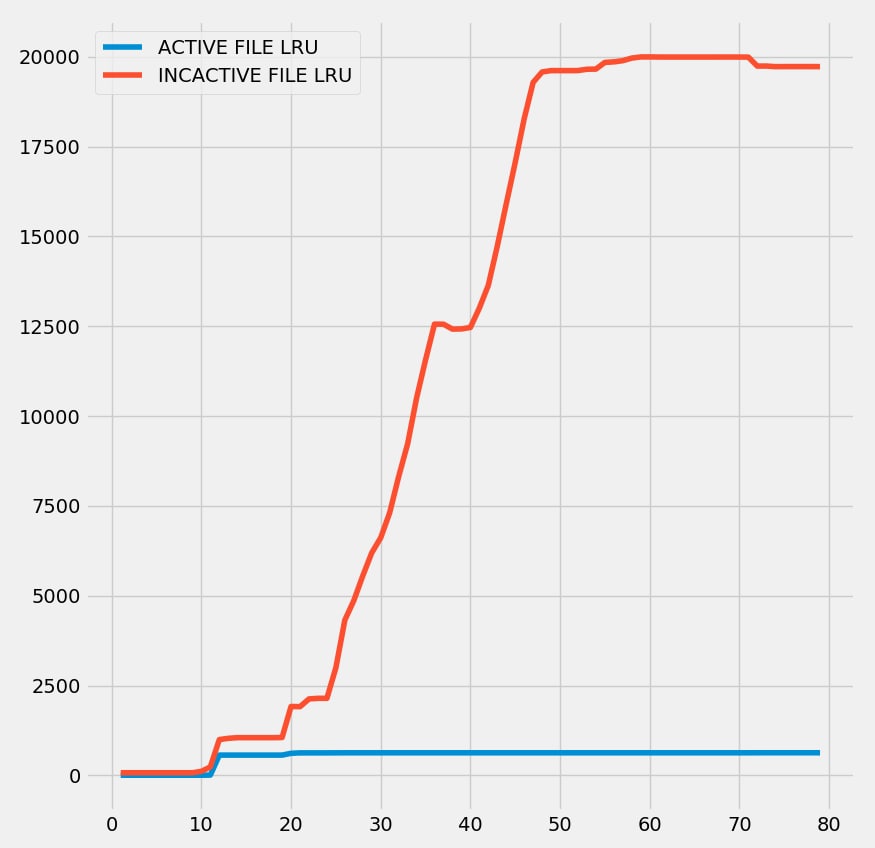
Closer.
If we copy this tarball to another file:
$ cp linux-4.19.252.tar.xz /tmp/l2
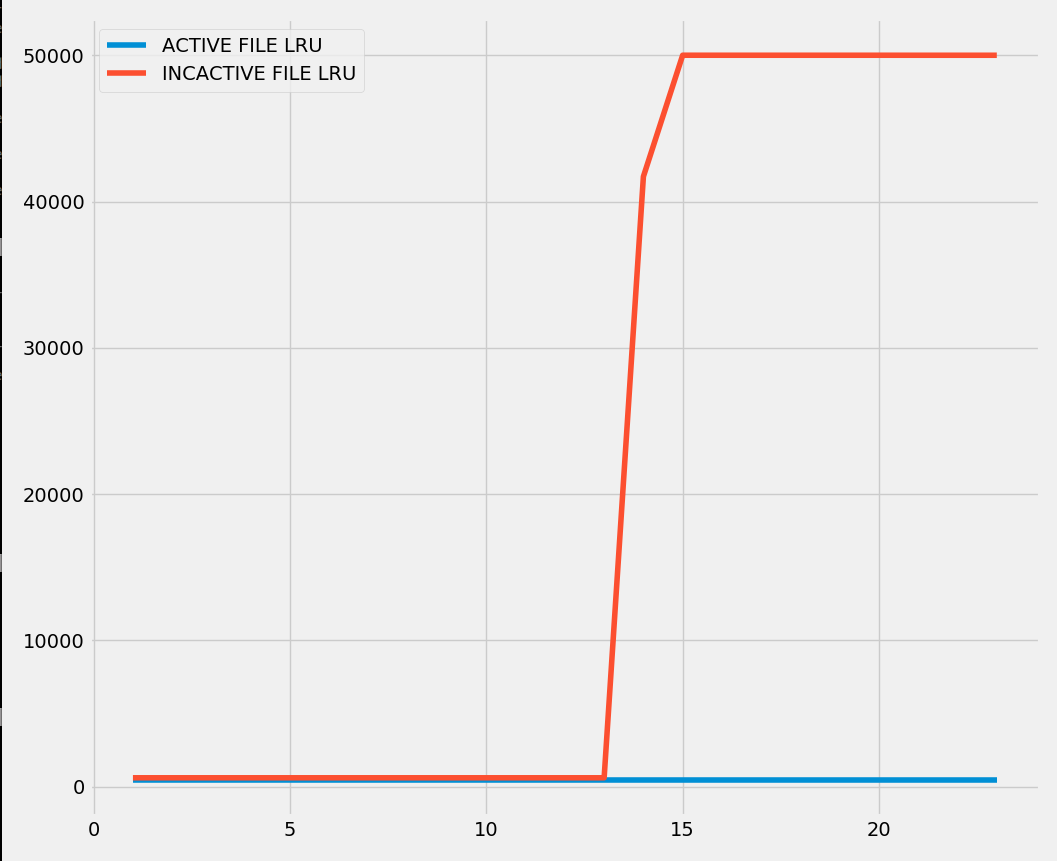
It makes sense. Copying any compressed file will populate the inactive list with high entropy pages, generating the same pattern than the ransomware attack.
Compressed data is ubiquitous and files are huge (browser data, software packages, etc.).
Quick conclusion: The approach is not viable. There will be a lot of false positives. Is it worth to keep going? I do not think so.
You can find the source code of this experiment here:
https://gitlab.etsit.urjc.es/esoriano/tindalos
Comments
You can comment this post in this tweet
(cc) Enrique Soriano-Salvador
Creative Commons (by-nc-nd).
Creative Commons, 559 Nathan Abbott Way, Stanford,
California 94305, USA.
Except the cool Hound of Tindalos picture